•••
I finally got around to Audrey Niffenegger’s oft-recommended The Time Traveler’s Wife this week. By coincidence, this immediately followed the new Joshua Ferris, The Unnamed, making two-in-a-row post-White Noise novels about the effects of debilitating disease on otherwise loving and fruitful marriages. What I’m left with is that Ferris knows his pathos, while The Time Traveler’s Wife gets added to the list of wildly popular entertainments that make me feel like I’m living alone in a nation of people speaking a different language.
What do people see in The Time Traveler’s Wife? I’d love to know. Is it the sense of accomplishment at getting through a 500-plus-page book that spells everything out in the first 50? Is it the on-the-nose statement of themes? Niffenegger treats book-club hot topics such as “free will v. predestination” and “true love v. adversity” with all the nuance and subtlety of a slasher flick serial killer opening wounds with a large kitchen knife. “…sometimes you tell me something and I feel like the future is already there, you know?” muses the 13-year-old Clare to the 36-year-old Henry, her future husband, early in the book. “Like my future has happened in the past and I can’t do anything about it.” Henry replies, “That’s called determinism. It haunts my dreams.” Much later, when adult Clare has taken up painting pictures of birds in cages, Henry wins the lottery for her. Hooey.
In Niffenegger’s unwillingness to toy with her “chrono-impairment” premise, she sets up an internal logic where the entire story is laid out in the first 50 pages of the book. She uses the rest of her ink telling you things you already know, throwing around dramatic miscarriages that are all the more unbearable for the knowledge that Henry and Clare will, in fact, have a beautiful, perfect, time-traveling daughter. This is a love story wrought with tension but devoid of mystery or possibility. The dual narrators’ extreme angst is borne of a happy and loving relationship that actually lasts quite a bit longer than most (from Clare’s age 6 to age 82, at least). I fail to see anything interesting in this, especially when stretched over 500 sensationalist pages.
Niffenegger, presumably paid by the word, fills entire chapters with thinly-veiled semi-autobiographical indulgences. Step-by-step descriptions of Clare making fancy paper in her art studio regularly perforate the already-flimsy forward momentum of her story. Niffenegger also gives Clare her own hometown (South Haven, MI) and adopted home city (Chicago) to serve as the two major settings. The book regularly reads like a series of Yelp reviews, detailing “Clare’s” favorite restaurants, museums and clubs in the Chicagoland area: “The waitress arrives, and we hurriedly consult our menus. I don’t want to bicker in Katsu, my favorite sushi restaurant, a place we eat at a lot. I reflect that Henry is counting on this, in addition to the intrinsic happiness of sushi, to placate me. We order goma-ae, hijiki, futomaki, kappamaki, and an impressive array of raw things on rice rectangles.” It’s one of the more graceless attempts that I’ve read by an author to shoehorn irrelevant agendas into a fiction— the book will even give you directions to some of these places, and their owners all get thanked in the acknowledgments.
But if you want an example of successfully integrating the setting into the mood and character of a piece, go to Ferris, who used Chicago pretty decently in his first-person-plural debut, Then We Came To The End, and sets most of The Unnamed in and around New York City. The hero here is Tim Farnsworth, an over-worked lawyer who doesn’t spend enough time with his family anyway but spends even less when afflicted with an unheard-of illness that drives him to set off on compulsory, involuntary walks. His legs have minds of their own, and his disease is weird, hilarious, pitiful and impossible to diagnose or cure.
 The Unnamed takes the right note from White Noise, the paranoia-fueled college campus of which mirrors the suburban upper-middle class malaise of Tim and his wife and daughter. Pre-apocalypse looms throughout the book; nature itself seems to be whispering in Tim’s ear that though he may feel alone, he is not. The city of New York is Tim’s comfort zone and he is often stricken to leave it, on foot, to nowhere and for no purpose.
The Unnamed takes the right note from White Noise, the paranoia-fueled college campus of which mirrors the suburban upper-middle class malaise of Tim and his wife and daughter. Pre-apocalypse looms throughout the book; nature itself seems to be whispering in Tim’s ear that though he may feel alone, he is not. The city of New York is Tim’s comfort zone and he is often stricken to leave it, on foot, to nowhere and for no purpose.You take these two afflictions at face value and they are pretty much the same thing: Tim and Henry are forced to cope with implausible, unbelievable diseases that threaten to destroy their marriages. The compulsory walking and the compulsory time travel relentlessly destroy everything from their physical bodies to their emotional well-being. But even as Henry’s chrono-impairment is unlikely to ever strike in our real world, Tim’s walking takes on a fantastical quality that actually anchors the story in its dying-world setting. The phrase for this is “internal logic,” in which Ferris could give Niffenegger a lesson or two. The Unnamed feels like a more inventive fiction than a story about time travel, and then manages to strike at our very real heartstrings in the exact same way The Time Traveler’s Wife fails to. The threat to Tim’s marriage, sanity and body is palpable, the dénouement heartbreaking. The Unnamed is a fable of our times, dealing in personal disconnection, technophobia and globalization with a deep empathy. The Time Traveler’s Wife is just cheese, and Swiss at that, full of holes and short on ham.
















